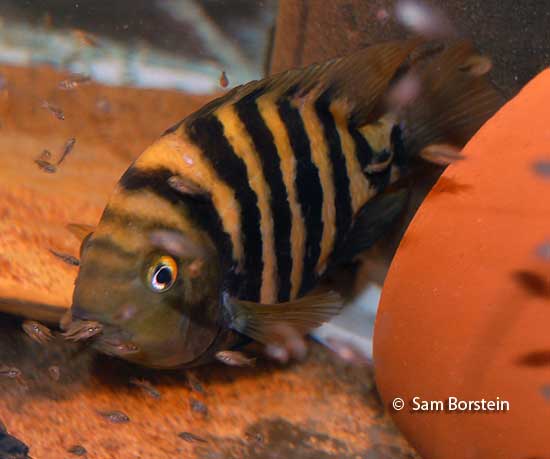Amphilophus amarillo
Stauffer & McKaye 2002

Above: A wild female Amphilophus amarillo with fry. Photo by Sam Borstein.
Etymology:
Genus- Amphi= on both sides (Greek), lophus= crest (Greek). Means crested on both sides.
Species- amarillo= yellow (Spanish).
Intro:
Amphilophus amarillo is a relatively new species of the genus first described by Stauffer in 2002. The type locality for this fish is Agua Caliente (Meaning hot water in Spanish), Lago Xiloa in Nicaragua, where this fish is endemic. Before the description the fish went by Amphilophus sp. "amarillo". Recently the fish has been bred and distributed thoroughly through the hobby.
This fish is closely related to the midas cichlid, Amphilophus citrinellus. The fish sports a very nice striping pattern of yellow and black bars. The chest and opercule on the fish is a very orange-yellow color.
Distribution:
Amphilophus amarillo is endemic to Lake Xiloa in Nicaragua.
Size, Maturity, and Sexual Dimorphism:
Size: Males- 14 inches, Females- 12 inches
Maturity: 6 inches
Sexual Dimorphism: Males are larger and may have longer fins. Males also develop a nuchal hump in some instances.

Above: A wild male Amphilophus amarillo with fry. Photo by Sam Borstein.
Care:
Amphilophus amarillo can be aggressive. It is almost certain that if you start with a large group you will wind up with a pair. Males are incredible rough on each other, and can give females a tough time. Compared to other fish of the Amphilophus genus, this species is not horrible. A large tank is needed, although a mid size, compatible breeding pair can be kept in a tank as small as a 55 gallon, although this is not recommended. A 6 foot tank or larger is really the ideal size for keeping this species.
The fish are large and produce a fair amount of waste, so make sure you have adequate filtration and keep up on water changes. 50% weekly water changes should keep your set up in good shape.
Diet:
Amphilophus amarillo is omnivorous and in aquaria is not difficult to feed. Mine gladly accepted Tetra Cichlid Sticks and Spectrum foods. These kept the fish in good condition.
Breeding:
Amphilophus amarillo is a substrate spawning cichlid and form relatively good pairs. I like to furnish the tank with flower pots and pieces of slate as breeding areas. The fish can be tricky to get into breeding condition.
Before spawning both of the male and females color intensifies. The male loses a lot of yellow and gains a lot of black color, while the female gets a more intense yellow color and more prominent black barring. The high contrast pattern of the female is quite attractive.
The fish lay anywhere from 300-2,000 eggs, which are fiercely guarded. The eggs hatch in about 5 days and in 9 days are free swimming. The fry are small, but large enough to eat newly hatched baby brine shrimp. They grow rapidly and the parental care is amazing. Be cautious keeping the fry with the parents for a long time as the fry contact feed off the parents slime coats and will literally eat holes in them. Make sure the fry are well fed.

Above: A wild female Amphilophus amarillo guarding fry. Photo by Sam Borstein.
Conclusion:
If you are a fan of Red Devils and Midas cichlids then you need to try these guys. They may be less popular than some of the other species of the Red Devil-Midas complex, but they are fairly easy to find from hobbyists. This is a very neat fish that a tank buster or Amphilophus lover should try.